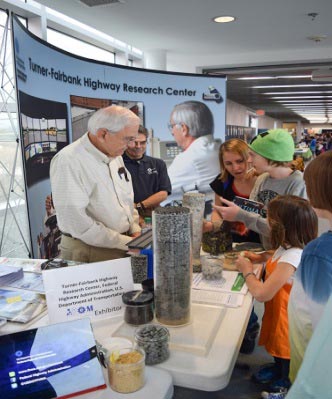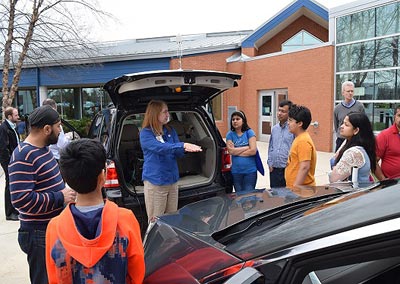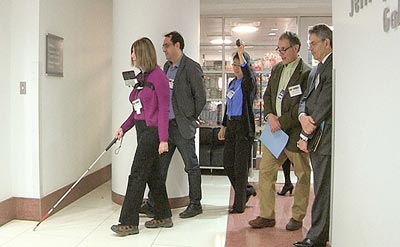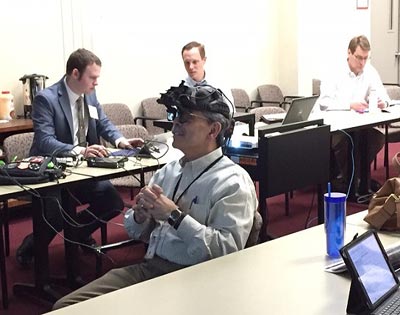U.S. Department of Transportation
Federal Highway Administration
1200 New Jersey Avenue, SE
Washington, DC 20590
202-366-4000
Federal Highway Administration Research and Technology
Coordinating, Developing, and Delivering Highway Transportation Innovations
|
R&T NOW This newsletter is an archived publication and may contain dated technical, contact, and link information. |
|
| Publication Number: N/A Date: March/April 2016 |
Publication Date: March/April 2016
|
PDF files can be viewed with the Acrobat® Reader®
FHWA Participates in SCOR Meeting
On March 17 and 18, 2016, FHWA’s Office of Research, Development, and Technology participated in a meeting held by the American Association of State Highway and Transportation Officials (AASHTO) Standing Committee on Research (SCOR). At the meeting, SCOR programmed approximately $32 million for the 2017 National Cooperative Highway Research Program (NCHRP). Prior to the meeting, a total of 117 potential research topics with an estimate cost of more than $56 million were submitted for consideration and went through at least two levels of assessment and comment by the States and FHWA.
SCOR acts as AASHTO’s driving force for high-quality transportation research and innovation to improve the Nation’s mobility of people and goods. Its mission is to support AASHTO and the transportation community by delivering strategic, high-quality research results while addressing development, technology transfer, and implementation.
SCOR’s responsibilities are to:
For more information, contact Jack Jernigan, 202-493-3363, jack.jernigan@dot.gov.
FHWA Takes Part in K-12 STEM Symposium
On March 12, 2016, staff from FHWA’s Turner-Fairbank Highway Research Center (TFHRC) participated in the 2016 K-12 STEM Symposium at The Nysmith School for the Gifted in Herndon, Virginia. The symposium provided an opportunity for children to discover new and exciting possibilities in the fields of science, technology, engineering, and mathematics (STEM) within the National Capital Region, including those with the U.S. Department of Transportation (USDOT) and FHWA.

TFHRC Research Civil Engineer Richard Meininger
explains the layers of a core sample to a student.
Michael Trentacoste, FHWA’s Associate Administrator for Research, Development, and Technology, and about 10 other Federal staff employees from TFHRC presented and displayed research and development technologies and discussed related activities. Activities for the day included hands-on experiences, such as student robotics teams, flight simulator competitions, three dimensional printers, and other science and mathematics exhibits.

TFHRC Transportation Research Engineer Deb Curtis talks about
connected vehicle technology with a group of students.
Students visiting TFHRC’s display learned about pavement and bridge engineering and connected vehicle technologies. Attendees also received information about high school and college STEM internships in government and industry.
Speakers at the symposium included Sandy Magnus, a former astronaut and the executive director of American Institute of Aeronautics and Astronautics, and Eric Schierling, a former fighter pilot and the program director at Vencore. Organizers of the event estimate that over 3,000 parents, students, and teachers attended.
For more information, contact Hiwot Abdi, 202-493-3999, hiwot.abdi@dot.gov.
FHWA Highlights Importance of TFHRC Research at ASCE-NCS Event
On February 16, 2016, Michael Trentacoste spoke to the American Society of Civil Engineers-National Capital Section (ASCE-NCS) about FHWA’s research and technology agenda, including its programs, strategies for the future, and emerging transportation technologies. His presentation, which took place at a networking and dinner event at the Hilton Arlington, highlighted how TFHRC plays a key role in leading the national transportation research needed to meet current and future challenges.
Research conducted at TFHRC is improving roads and bridges, saving lives, reducing congestion, and advancing economic growth. Important work is occurring in such areas as connected vehicles and vehicle-to-infrastructure communications, road and bridge design, policy decisions requiring quality transportation data, human factors studies, environmentally sustainable roads, and robotic infrastructure assessment.
For more information, contact Hiwot Abdi, 202-493-3999, hiwot.abdi@dot.gov.
FHWA Supports NSF’s Cyber-Physical Systems Program
The National Science Foundation (NSF) recently released a solicitation for a unique opportunity for investigators to support its Cyber-Physical Systems Program. Cyber-physical systems (CPS) are engineered systems built from and dependent on the seamless integration of computational algorithms and physical components. As FHWA has an interest in research and development that provides improved safety, mobility, and energy conservation in the development and operation of the highway system, it is working closely with NSF and other Federal agencies on CPS. In the context of highway transportation, CPS must be scalable, reliable, adaptable, and secure while also being cost-effective.
In particular, FHWA is interested in fundamental research aimed at solving important public needs. It also seeks research that can scale across transportation systems, modes, and into other domains. Approaches should consider the open nature of the transportation system, legacy components and processes, and the distributed nature of asset ownership and operations. FHWA encourages utilization of existing test beds, pilot deployments, and real world data. The CPS Program solicitation (16-549) will be soon available on NSF’s Web site.
The synopsis is available at https://www.nsf.gov/funding/pgm_summ.jsp?pims_id=503286.
For more information, contact: David Kuehn, david.kuehn@dot.gov, 202-493-3414.
EAR Program Issues RFI for Inductive Charging Systems and Roadway Pavement Design and Durability
FHWA’s Exploratory Advanced Research (EAR) Program and TFHRC have issued a Request for Information (RFI) to find organizations that have developed inductive charging systems for placement in roadway pavement. FHWA’s primary interest is to understand different engineering designs, how the systems integrate with roadway pavement types, and assess impacts on pavement construction, maintenance, performance, functionality and durability for both static and dynamic charging configurations.
Additional information is detailed in the RFI located at https://www.fbo.gov/index?s=opportunity&mode=form&id=1352b6f92593688da75eac98746d1f96&tab=core&_cview=0. Responses are requested by May 5, 2016.
For more information, contact David Kuehn, david.kuehn@dot.gov, 202-493-3414.
Reports on Novel Surface Transportation Modes Available
Two EAR Program reports on novel surface transportation modes have recently been released. The report, “Novel Surface Transportation Modes,” is aimed at advancing an understanding of novel surface transportation concepts and facilitating interaction and information sharing among the USDOT, State and local governments, and private sector innovators. The report also explores the public sector’s role in enhancing transportation innovation. “Novel Modes Workshop” is a summary report of a workshop to assess and document the state of technology for new modal systems. The event explored potential technological trends that could affect highway, transit, and rail systems. It also established a foundation for considering government policy and research roles for novel modal systems and offered open access to innovators and academic sectors.
“Novel Surface Transportation Modes,” is available to download at www.rita.dot.gov/sites/default/files/NovelSurfTranspModes-web.pdf. “Novel Modes Workshop” is available at www.rita.dot.gov/sites/default/files/NovelModesWkshop-web.pdf.
For more information, contact David Kuehn, 202-493-3414, david.kuehn@dot.gov.
EAR Program Demos New Assistive Technologies for the Visually Impaired
FHWA’s EAR Program is sponsoring research focused on adapting sensor and guidance technology found on luxury passenger vehicles for use by blind and vision impaired pedestrians. On March 3, 2016, the EAR Program demonstrated the Intelligent Situation Awareness and Navigation Aid (ISANA) at USDOT headquarters in Washington, DC. Researchers equipped Barbara Campbell, a visually-impaired test subject, with ISANA’s tablet-based, wearable technology.

Barbara Campbell, a visually-impaired test subject, uses ISANA technology
to navigate to the eighth floor in USDOT headquarters.
Using ISANA, and with additional assistance, she successfully navigated USDOT headquarters, moving from the main security entrance in the West Building to the eighth floor of the East Building. Since GPS is not available to indoor receivers, a fish eye lens and custom software on the tablet interpreted the visual environment for her in real time and provided Barbara with voice guidance to help her navigate potential obstacles and provide situational awareness of her surroundings.
Funded through the EAR Program, and conducted in coordination with the John A. Volpe National Transportation Systems Center (Volpe), the Federal Transit Administration, and the Intelligent Transportation Systems Joint Program Office (ITS-JPO), the multiyear project is focused on developing technology that provides guidance assistance to blind and visually-impaired pedestrians navigating in large, unstructured environments. The new technology is in the earliest stages of research and is still many years away from being market-ready.
For more information, contact Mohammed Yousuf, 202-493-3199, mohammed.yousuf@dot.gov.
TRB Webinar to Focus on Technology Readiness Level Assessment
On April 28, 2016, from 2 to 3:30 p.m., the Transportation Research Board (TRB) will conduct a Webinar to present an overview of Technology Readiness Level (TRL) Assessment for describing the maturity of highway research products identified by FHWA and developed by Volpe. The 90-minute Webinar will include background information on the assessment tool, examples of its use, lessons on how it can be applied to highway transportation research programs, and questions and answers. Presenters will introduce the topic and discuss TRL assessment and lessons learned from applying technology readiness assessments. Nate Deshmukh-Towery from Volpe and David Kuehn from FHWA’s Exploratory Advanced Research Program will participate as moderator and presenter respectively.
More information about the Webinar, including pricing information, is available at www.trb.org/ElectronicSessions/Blurbs/173937.aspx
For registration questions, contact Reggie Gillum, rgillum@nas.edu.
Researchers Instruct GMU Students at TFHRC
For the twelfth consecutive year, FHWA’s Office of Infrastructure Research and Development is teaching “Introduction to Experimental Design Engineering” to civil engineering students from George Mason University (GMU). During the 15-week semester, GMU students will receive lectures from representatives of TFHRC’s Structures, Hydraulics, Asphalt Pavements, Concrete Pavements, and Geotechnical Laboratories and perform experiments in each of these labs. The class provides GMU students with a survey of common testing and laboratory experimental methods that civil engineers might encounter in their professional practice. The senior-level elective is one of a number of collaborative activities detailed in a Memorandum of Understanding signed in 2004 between GMU and FHWA.
For more information, contact Yamayra Rodriguez, 202-493-3252, yamayra.rodriguez@dot.gov.
FHWA Delivers Webinar on UHPC Connections for ABC
On January 21, 2016, FHWA’s Ben Graybeal delivered a Webinar on ultra-high performance concrete (UHPC) connections for accelerated bridge construction (ABC) that attracted more than 650 unique participant sites from across the United States and internationally. Held in conjunction with Florida International University’s ABC Webinar Series, the session focused on introducing the audience to the design, construction, and performance of field-cast UHPC when used in connections between prefabricated bridge elements. The technology, which is part of FHWA’s Every Day Counts 3 initiative, is in service in more than 130 bridges in the United States and Canada.
For more information, contact Ben Graybeal, 202-493-3122, benjamin.graybeal@dot.gov.
Awards Presented to Winners of LTPP’s International Data Analysis Contest
The winners of FHWA’s Long-Term Pavement Performance (LTPP) International Data Analysis Contest received awards for papers at the Transportation Research Board’s 95th Annual Meeting in Washington, DC. Xueqin Chen, a visiting student from Tongji University at the University of Tennessee, won an award in the challenge category for her paper, “Development of Distress Condition Index Using the LTPP Data through Structural Equation Modeling.” In the graduate category, Ronell Eisma of Michigan State University received an award for his paper, “Evaluation of the Effectiveness of Diamond Grinding Treatments Due to Site Factors and Profile Characteristics.”
For more information, contact Aramis López, 202-493-3145, aramis.lopez@dot.gov.
USDOT ITS Joint Program Office Launches OSADP 2.0
The USDOT ITS-JPO has made significant updates to the second version of the Open Source Application Development Portal (OSADP 2.0), which offers multiple ways for users to browse content and find ITS-related applications.
OSADP 2.0 provides Web-based access and collaboration on source code and documentation for innovative, open source transportation applications. Featuring connected vehicle and other ITS-related applications from the USDOT ITS Program, OSADP 2.0 has 39 applications and related resources available to download. It also offers other sources to support use and development and is continually updated. All content is quality-checked, well-documented, and freely available to registered users.
Application developers, researchers, and others are invited to explore how they might use this resource, which is available at http://itsforge.net.
For more information, contact Jon Obenberger, 202-493-3265, jon.obenberger@dot.gov.
New Connected Vehicle Data Sets Available on Research Data Exchange
Two months of data from the Safety Pilot Model Deployment (SPMD) program are available on the Research Data Exchange (RDE) at www.its-rde.net. The data sets contain sanitized mobility hyper-frequent, hyper-local data elements collected from about 3,000 vehicles equipped with connected vehicle technologies while traversing the roadway network in the Ann Arbor, Michigan metropolitan area. This connected vehicle driving data is a valuable resource to facilitate analyses, providing insights into safety, network mobility, and performance implications with integrating connected vehicle related data into the development of the next generation of tools and solutions for practitioners to address today’s transportation challenges.
The five SPMD data sets located on the RDE include:
Version 2.3 of the RDE is now available. This version provides a Data Graph tool as an alternative method to view data and select subsets of the Safety Pilot Model Deployment data environment. This tool allows data sets or records to be graphically displayed. The RDE also has a new download process that eliminates waiting after custom requests for data; a link is emailed to users when the data file has been produced and is ready to access. The RDE is a Web-based data resource provided by the USDOT ITS Program that collects, manages, and provides access to archived and real-time multisource and multimodal connected vehicle related data to support the development and testing of ITS applications.
For more information, contact Gene McHale, 202-493-3275, gene.mchale@dot.gov, or Jon Obenberger, 202-493-3265, jon.obenberger@dot.gov.
Report Available on Truck Following Behavior
Volpe conducted research that is described in a recent report titled, “Naturalistic Study of Truck Following Behavior.” The goal of the study was to support FHWA’s Office of Research, Development, and Technology in developing automated applications for truck platooning. Grouping vehicles into platoons (a series of vehicles traveling together with short following distances) is a method of safely increasing road capacity by using automation technologies and electronic coupling to decrease distances between vehicles. Using two naturalistic heavy-truck data sets collected from previous research, Volpe quantified heavy truck following behavior in the following categories: how closely trucks follow other trucks and passenger cars on freeways; how following behavior varies by road weather and visibility; following distances at which other vehicles will cut-in between a truck and a lead vehicle; and the safety impact of different headways.
The report is available to download at http://ntl.bts.gov/lib/56000/56800/56891/Truck_Platooning.pdf.
For more information, contact Govind Vadakpat, 202-493-3283, g.vadakpat@dot.gov.
USDOT Hosts ATTRI State of the Practice, Innovation, and Assessment of Research Webinar
On February 2, 2016, USDOT hosted a free public Webinar to review the recently completed state of the practice and innovation scan reports, as well as the assessment of relevant research document for the USDOT’s Accessible Transportation Technologies Research Initiative (ATTRI). The Rehabilitation Engineering Research Center on Accessible Public Transportation (RERC-APT), which is funded by the National Institute on Disability, Independent Living and Rehabilitation Research (NIDILRR), shared the results of the state of practice scan, innovation scan, and assessment of relevant research documents; it used specific examples from accessible transportation and related fields that illustrated how methods, practices and technologies can meet the needs of transportation users of all abilities. The Webinar was sponsored by the USDOT ITS Joint Program Office in cooperation with NIDILRR.
For more information, contact Mohammed Yousuf, 202-493-3199, mohammed.yousuf@dot.gov.
Data Collection for Motorcycle Crash Causation Study Complete
FHWA has completed data collection for a Motorcycle Crash Causation Study (MCCS), which includes 351 usable cases and 702 control rider interviews. Authorized under the Safe, Accountable, Flexible, Efficient Transportation Equity Act: A Legacy for Users (SAFETEA-LU), the study is focused on assembling data that can be used to investigate causes of motorcycle crashes in the United States. Data for the MCCS, which is the largest study of its kind in 30 years, was collected from June 2011 to January 2016.
Through a cooperative agreement with Oklahoma State University and in coordination with National Highway Traffic Safety Administration (NHTSA) and other research partners, a team of field investigators conducted in-depth investigations into motorcycle crashes in Orange County, California. Collected data elements include information on the motorcycle type, rider demographics, roadway characteristics, traffic details, alcohol use, rider behaviors, and other factors related to the crash event. Crash investigations include onsite physical investigations, onsite interviews with crash participants, follow up vehicle inspections, follow up interviews, and injury data collection. Police jurisdictions in Orange County, California played a vital role in the success of this effort.
The resulting motorcycle crash causation database is expected to serve as a foundation for motorcycle safety research for years to come. Funding partners for the MCCS include FHWA, NHTSA, and the American Motorcyclist Association. Participating State departments of transportation (DOTs), include the Iowa DOT, New Mexico DOT, New York State DOT, Ohio DOT, Oklahoma DOT, Texas DOT, and Wisconsin DOT.
The research team is now working to finalize the database and supporting documentation. FHWA anticipates that highway safety researchers will have access to all of data through the Highway Safety Information System Web site sometime in 2016.
For more information, contact Craig Thor 202-493-3338, craig.thor@dot.gov.
TCD Pooled Fund Consortium Expands to 26 State DOT Members
FHWA’s Traffic Control Device (TCD) Pooled Fund Consortium is expanding rapidly. The Alabama, Delaware, and Montana DOTs recently joined, increasing State DOT membership to 26. The International Bridge Tunnel and Turnpike Association has also joined.
The purpose of the TCD Pooled Fund Consortium is to fund the systematic evaluation of novel TCDs, employing a consistent process that addresses safety, human factors, and operations issues for each proposed TCD concept. TCD Pooled Fund research will address TCD issues identified by local and State jurisdictions, industry, and other transportation safety organizations. These efforts will comply with the Manual on Uniform Traffic Control Devices (MUTCD) rule-making process, helping to incorporate novel TCDs into the MUTCD.
An example of TCD output is the report, “Guide Sign Design,” available on the TCD Web site, http://pooledfund.org/Details/Study/565. TCD members have noted that guide sign design and use is still inconsistent in the field. In support of improved guide sign effectiveness and consistency, they proposed a comprehensive scan of existing guidance sign design principles and practices.
For more information, contact Jim Shurbutt, 202-493-3420, jim.shurbutt@dot.gov.
Turner-Fairbank Helps Advance DDI Project in Anchorage
Research conducted at the Turner-Fairbank Highway Research Center has been instrumental in advancing a diverging diamond interchange (DDI) project in Anchorage, Alaska. Nopa Kronprasert and Wei Zhang, researchers at TFHRC, provided extensive technical assistance (including engineering analysis, simulation analysis, and an explanation of traffic engineering principles) to help advance the Glenn Highway and Muldoon Road Diverging Diamond proposal to multiple stakeholders, including the City of Anchorage, the public, the developer, and the Alaska Department of Transportation and Public Facilities.
The design of the DDI has been completed and construction is scheduled to begin this spring. Expected to reduce the number of crashes and increase traffic capacity, the new interchange will allow vehicles to avoid crossing opposing traffic when entering or exiting the highway. The new DDI will make merging with Muldoon Road safer and easier and includes a network of separated paths for pedestrians and cyclists and maintains connectivity with the existing trail system along the Glenn Highway.
A short video about the project is available at https://www.youtube.com/watch?v=p_YAZgobYOc.
For more information, visit http://www.glennmuldoon.com/projects/GlennMuldoon/index.html, or contact Wei Zhang, 202-493-3317, wei.zhang@dot.
BARRACUDA System to Provide Immediate Benefits to Motorcyclists
To address the need for a motorcycle-specific hazard tracking or alerting system, Charles River Analytics has designed and demonstrated the feasibility of a system for Bayesian Assessments and Real-Time Rider Alerting and Cueing for Upcoming Danger Avoidance (BARRACUDA). The project recently completed Phase I of a USDOT Small Business Innovation Research effort and a Phase II proposal is expected in early spring.

Michael Trentacoste, FHWA’s Associate Administrator for Research, Development,
and Technology, participates in a demonstration of the BARRACUDA heads-up
display symbology as it would be displayed for a rider negotiating the streets of Boston.
The BARRACUDA system is expected to provide immediate benefits to motorcyclists by significantly enhancing both safety and hazard awareness through both pre-departure route risk assessment capabilities and real-time sensing and display of critical roadway hazards. The technology presents information to riders through a smartphone application and an augmented reality heads-up display symbology. Enhancing rider safety for motorcyclists with en route hazard information is a novel capability that is not currently available in non-distracting formats or tailored for motorcycle-specific hazards.
For more information, contact Craig Thor, 202-493-3338, craig.thor@dot.gov.
FHWA Releases Version 11.1.0 of Interactive Highway Safety Design Model
FHWA released version 11.1.0 of the Interactive Highway Safety Design Model (IHSDM), a suite of software analysis tools for evaluating safety and operational effects of geometric design decisions. Version 11.1.0 includes a new Crash Modification Factors Report as part of the Crash Prediction Module output. It also features enhancements to the Policy Review Module, including new policy checks for bike lane width on rural two-lane highways and stopping sight distance and decision sight distance on rural multilane highways.
IHSDM supports the Data-Driven Safety Analysis initiative as part of FHWA’s Every Day Counts 3 efforts. The IHSDM Crash Prediction Module serves as a faithful implementation of Highway Safety Manual Predictive Methods (Part C) for two-lane rural highways, multilane rural highways, urban and suburban arterials, freeways, and ramps/interchanges. The complete IHSDM suite consists of six modules.
The software is available for free download at www.ihsdm.org.
For more information, visit www.fhwa.dot.gov/research/tfhrc/projects/safety/comprehensive/ihsdm/index.cfm, or contact Abdul Zineddin, 202-493-3288, abdul.zineddin@dot.gov.
Public Roads—January/February 2016
This issue includes: Moving Beyond Traffic; Stop or Go?; The Roads Less Traveled; Commuting in a Post-Baby Boomer World; Digitizing for Better Decisionmaking; and Leveraging a Data-Rich World.
It is available online via www.fhwa.dot.gov/publications/publicroads/16marapr/index.cfm.
For more information, contact TaMara McCrae, tamara.mccrae@dot.gov.
Innovator: Accelerating Innovation for the American Driving Experience—March/April 2016
This issue includes: Agencies Add Geosynthetic Reinforced Soil-Integrated Bridge System to Toolboxes; Warm-Mix Asphalt Takes Off; Leading Innovation; States Choose e-Construction to Save Time and Money; Project Tests Safety Benefits of Solar-Powered Traffic Signs; States Innovate!; and Events.
The issue is available online via www.fhwa.dot.gov/hfl/innovator/e-version/issue_53/.
Turner-Fairbank Highway Research Center: www.fhwa.dot.gov/research/tfhrc/
Resource Center: www.fhwa.dot.gov/resourcecenter/
National Highway Institute: www.nhi.fhwa.dot.gov/home.aspx
Please forward this newsletter to others you think might find it interesting and/or useful.
Suggestions may be submitted to: FHWA_Now@fhwa.dot.gov